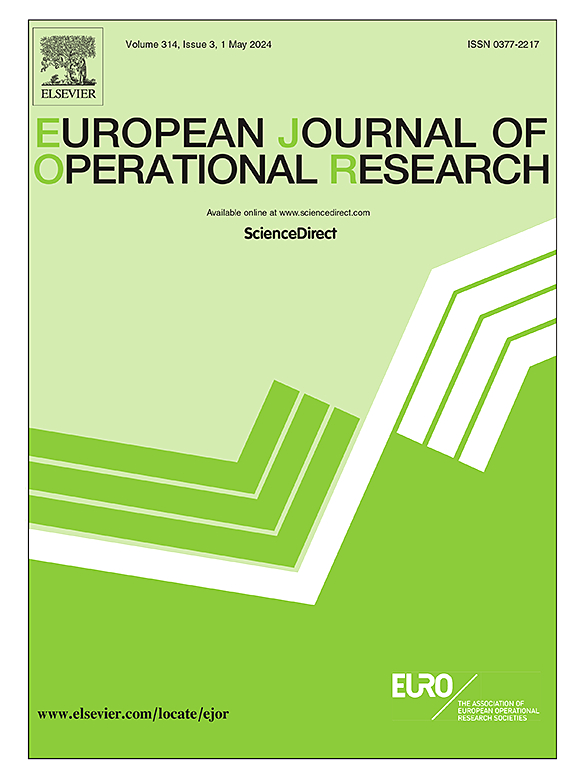When Should Metaverse Technology be Adopted in Live Streaming Considering Consumer Returns?
IF 6
2区 管理学
Q1 OPERATIONS RESEARCH & MANAGEMENT SCIENCE
引用次数: 0
Abstract
Consumer returns are common in live streaming selling, and metaverse technology is gradually advocated to solve the issue of consumer returns since this technology can significantly enhance the live streaming shopping experience. We consider a supply chain composed of a manufacturer and a retailer with two live streaming scenarios: ML and RL. In scenario ML (RL), the manufacturer (retailer) invites an influencer to open a live streaming channel. We explore the impacts of influencer power and consider the integration of metaverse technology. Our analytical results reveal the following: Under scenario ML, the adoption of metaverse technology increases the manufacturer’s optimal profit at a moderate unit cost of metaverse technology with high influencer power or at a low unit cost. When the manufacturers introduce live streaming, they should adopt metaverse technology when choosing influencers with relatively high influencer power as the unit cost is moderate in the development phase of metaverse technology. Under scenario RL, the retailer should only adopt metaverse technology at a high unit cost with low influencer power or at a low unit cost with high influencer power. This implies a counterintuitive strategy: when cooperating with influencers with lower influencer power, the retailers should adopt metaverse technology despite high costs. Furthermore, regardless of metaverse technology adoption, scenario RL (ML) brings more profit to the manufacturer if influencer power is low (high). This indicates that manufacturers and retailers should choose influencers with greater influence power when introducing live streaming. By extending our model, we examine the robustness of our findings under the scenarios involving channel competition, omni-channel strategy, and live streaming slicing. This study is the first to explore the adoption strategies of metaverse technology in different live streaming supply chain structures considering consumer returns, providing valuable guidance for manufacturers and retailers on when to adopt metaverse technology.考虑到消费者的回报,什么时候应该在直播中采用虚拟现实技术?
消费者退货是直播销售中常见的问题,由于虚拟世界技术可以显著提升直播购物体验,因此逐渐被提倡解决消费者退货问题。我们考虑一个由制造商和零售商组成的供应链,有两个实时流场景:ML和RL。在场景ML (RL)中,制造商(零售商)邀请有影响力的人打开一个直播频道。我们探讨了影响者权力的影响,并考虑了虚拟世界技术的整合。我们的分析结果显示:在情景ML下,采用元域技术,在具有高影响力的元域技术的中等单位成本或较低的单位成本下,制造商的最优利润增加。厂商在引入直播时,在选择网红力量相对较高的网红时,应该采用元界技术,因为元界技术发展阶段的单位成本适中。在RL情景下,零售商只应以高单位成本和低影响者力量或低单位成本和高影响者力量采用meta - verse技术。这意味着一种违反直觉的策略:当与影响力较低的网红合作时,零售商应该不惜高成本采用元verse技术。此外,无论采用何种元宇宙技术,如果影响者权力低(高),则场景RL (ML)会为制造商带来更多利润。这表明,制造商和零售商在引入直播时,应该选择影响力更大的网红。通过扩展我们的模型,我们在涉及渠道竞争、全渠道策略和直播切片的场景下检验了我们的发现的稳健性。本研究首次探讨了在考虑消费者回报的情况下,在不同的直播供应链结构中采用元宇宙技术的策略,为制造商和零售商何时采用元宇宙技术提供了有价值的指导。
本文章由计算机程序翻译,如有差异,请以英文原文为准。
求助全文
约1分钟内获得全文
求助全文
来源期刊

European Journal of Operational Research
管理科学-运筹学与管理科学
CiteScore
11.90
自引率
9.40%
发文量
786
审稿时长
8.2 months
期刊介绍:
The European Journal of Operational Research (EJOR) publishes high quality, original papers that contribute to the methodology of operational research (OR) and to the practice of decision making.
 求助内容:
求助内容: 应助结果提醒方式:
应助结果提醒方式:


